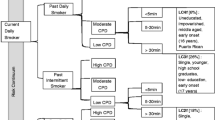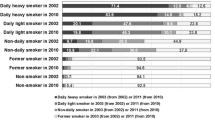Abstract
This article presents probability estimates of smoking prevalence for the Latino adult population in California and examines differences in smoking prevalence and nicotine dependence between different levels of education and acculturation and between different ethnic and gender groups. Prevalence estimates are based on the California Baseline Tobacco Survey (CTS). The CTS is a Random Digit Dial Survey including N=70,997 non-Latino Whites and 28,000 Latino adults. Overall smoking prevalence among Latinos was estimated at 24.4% for men and 12.0% for women. Multiple logistic regression analyses suggest higher smoking prevalence and higher nicotine dependence for men than for women, for individuals who have not finished high school, for non-Latinos when compared to Latinos, and for Latinos of high level of acculturation when compared to Latinos of low level of acculturation. These estimates can serve as baselines to evaluate progress toward year 2000 health objectives. Findings stress the importance of taking into account socio-economic level when comparing Latinos and other ethnic groups on health behaviors. Moreover, findings suggest that interventions helping Latinos quit smoking are most needed for men with twelve years or less of formal education and stress the importance of programs to prevent smoking uptake, specifically among Latinos of low level of acculturation.
Similar content being viewed by others
References
Bureau of the Census:Statistical Abstract of the United States. Washington, DC: U.S. Department of Commerce, 1993.
Marín G, Marín BV:Research with Hispanic Populations. New-bury Park, CA: Sage Publications, 1991.
U.S. Department of Health and Human Services:Healthy People 2000: National Health Promotion and Disease Prevention Objectives. Washington, DC: U.S. Department of Health and Human Services, 1991.
Delgado JL, Johnson CL, Roy I, Treviño FM: Hispanic Health and Nutrition Examination Survey: Methodological considerations.American Journal of Public Health. 1990,80:6–10.
Haynes SG, Harvey C, Montes H, Nickens H, Cohen BH: Patterns of cigarette smoking among Hispanics in the United States: Results from HANES 1982–84.American Journal of Public Health. 1990,80:47–53.
Escobedo LG, Remington PL: Birth cohort analysis of prevalence of cigarette smoking among Hispanics in the United States.Journal of the American Medical Association. 1989,261:66–69.
Escobedo LG, Remington PL, Anda RF: Long-term age-specific prevalence of cigarette smoking among Hispanics in the United States.Journal of Psychoactive Drugs. 1989,21:307–318.
Pérez-Stable EJ, Marín BV, Marín G: A comprehensive smoking cessation program for the San Francisco Bay area Latino community: Programa Latino para dejar de fumar.American Journal of Health Promotion. 1993,7:430–442.
Marín BV, Pérez-Stable EJ, Marín G, Sabogal F, Otero-Sabogal R: Attitudes and behaviors of Hispanic smokers: Implications for cessation interventions.Health Education Quarterly. 1990,17:287–297.
Marcus AC, Crane LA: Smoking behavior among Hispanics: A preliminary report.Progress in Clinical and Biological Research. 1984,156:141–151.
Rogers RG, Crank J: Ethnic differences in smoking patterns: Findings from NHIS.Public Health Reports. 1988,103:387–393.
Markides KS, Coreil J, Ray LA: Smoking among Mexican-Americans: A three-generation study.American Journal of Public Health. 1987,77:708–711.
Pierce J, Goodman J, Gilpin E, Berry C:Technical Report on Analytic Methods and Approaches Used in the Tobacco Use in California, 1990–1991 Report. Book 1. San Diego, CA: University of California, 1992.
Marín G, Sabogal F, Marín BV, Otero-Sabogal R, Pérez-Stable E: Development of a short acculturation scale for Hispanics.Hispanic Journal of Behavioral Sciences. 1987,9:183–205.
Benson V, Maranom MA:Current Estimates from the National Health Interview Survey. Washington, DC: National Center for Health Statistics, Vital and Health Statistics, 1994, 10(189).
Fagerström KO: Measuring degree of physical dependence to tobacco smoking with reference to individualization of treatment.Addictive Behaviors. 1978,3:235–241.
Lichtenstein E, Mermelstein RJ: Some methological cautions in the use of the tolerance questionnaire.Addictive Behaviors. 1986,11:439–442.
Gritz ER, Carr CR, Marcus AC: The tobacco withdrawal syndrome in unaided quitters.British Journal of Addiction. 1991,86:57–69.
Sabogal F, Otero-Sabogal R, Marín BV, Marín G, Perez-Stable E: Medición de la dependencia al cigarrillo: Validación de una escala corta para latinos (Measurement of addiction of a short scale for Latinos).Avances en Psicología Clínica Latinoamericana. 1989,7:89–104.
Winkleby MA, Fortmann SP, Rockhill B: Health-related risk factors in a sample of Hispanics and Whites matched on sociode-mographic characteristics.American Journal of Epidemiology. 1993,137:1365–1375.
Booth MW, Castro FG, Anglin MD: What do we know about Hispanic substance abuse? In Glick R, Moore J (eds).Drugs in Hispanic Communities. New Brunswick, NJ: Rutgers University Press 1990, 21–43.
U.S. Department of Health and Human Services:Smoking and Health in the Americas. Atlanta, GA: U.S. Department of Health and Human Services, Public Health Service, Centers for Disease Control, National Center for Chronic Disease Prevention and Health Promotion, Office on Smoking and Health, 1992.
Cornelius WA: From sojourners to settlers: The changing profile of Mexican immigration to the United States. In Bustamante JA, Reynolds CW, Jinojosa Ojeda RA (eds),U.S-Mexico Relations—Labor Market Interdependence. Stanford, CA: Stanford University Press, 1992, 154–195.
Pérez-Stable EJ, Marín G, Brody DJ, Benowitz NL: Apparent underreporting of cigarette consumption among Mexican-American smokers.American Journal of Public Health. 1990,80: 1057–1061.
Coultas DB, Howard CA, Peake GT, Skipper BJ, Samet JM: Discrepancies between self=reported and validated cigarette smoking in a community survey of New Mexico Hispanics.American Review of Respiratory Diseases. 1988,137:810–814.
Hayes-Bautista DE, Hurtado A, Valdez RB, Hernandez ACR: No longer a minority: Latinos and social policy in California. Los Angeles: UCLA Chicano Studies Research Center, 1992.
Author information
Authors and Affiliations
Additional information
Preparation of this manuscript was supported in part by The Tobacco Tax Health Protection Act of 1988, Proposition 99, Tobacco-Related Disease Research Program, grant number 3KT-0031.
The author wishes to thank Drs. Charles C. Berry, Robert M. Kaplan, Georg E. Matt, and John P. Pierce for their thoughtful comments on an earlier version of this paper and Bradley P. Rosbrook for his assistance in conducting data analyses.
About this article
Cite this article
Navarro, A.M. Cigarette smoking among adult Lations: The California Tobacco Baseline Survey. Ann Behav Med 18, 238–245 (1996). https://doi.org/10.1007/BF02895285
Issue Date:
DOI: https://doi.org/10.1007/BF02895285




